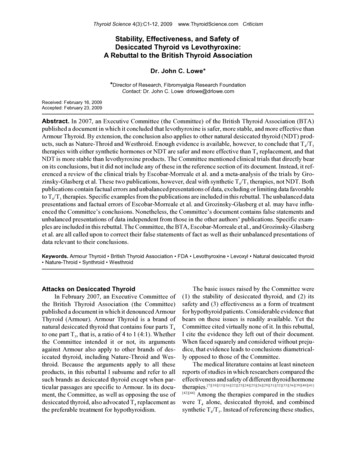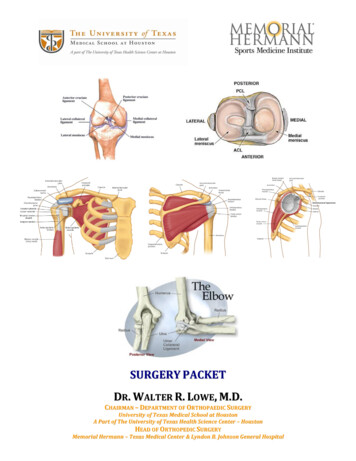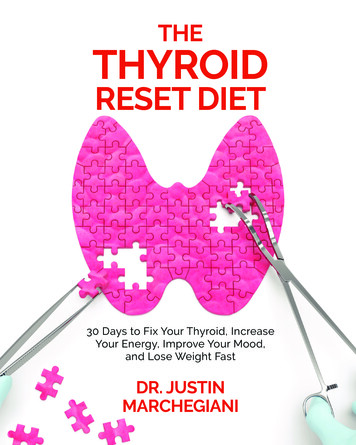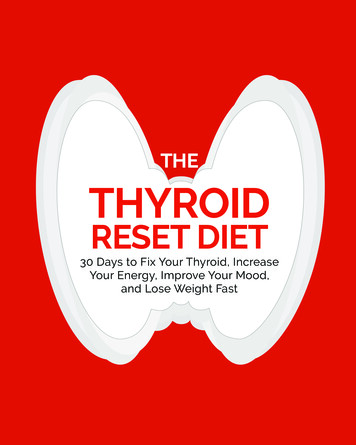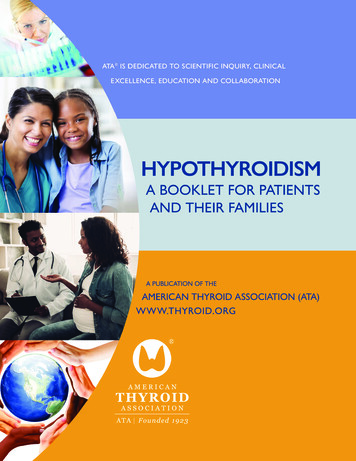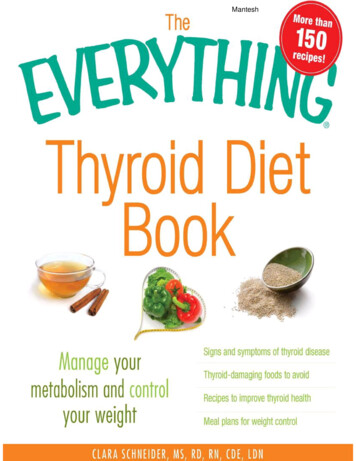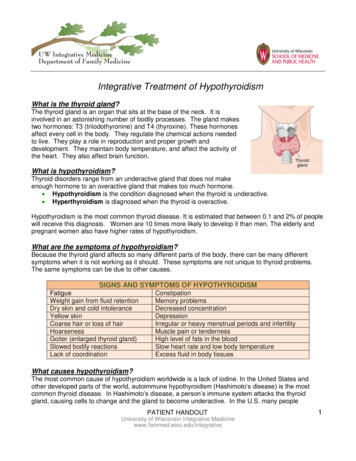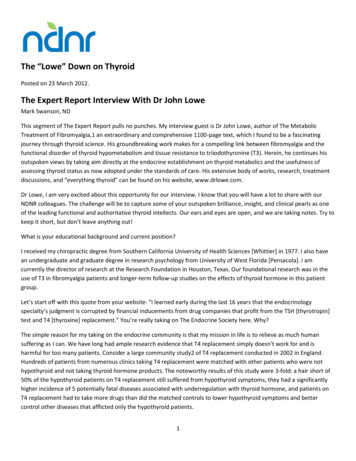
Transcription
The “Lowe” Down on ThyroidPosted on 23 March 2012.The Expert Report Interview With Dr John LoweMark Swanson, NDThis segment of The Expert Report pulls no punches. My interview guest is Dr John Lowe, author of The MetabolicTreatment of Fibromyalgia,1 an extraordinary and comprehensive 1100-page text, which I found to be a fascinatingjourney through thyroid science. His groundbreaking work makes for a compelling link between fibromyalgia and thefunctional disorder of thyroid hypometabolism and tissue resistance to triiodothyronine (T3). Herein, he continues hisoutspoken views by taking aim directly at the endocrine establishment on thyroid metabolics and the usefulness ofassessing thyroid status as now adopted under the standards of care. His extensive body of works, research, treatmentdiscussions, and “everything thyroid” can be found on his website, www.drlowe.com.Dr Lowe, I am very excited about this opportunity for our interview. I know that you will have a lot to share with ourNDNR colleagues. The challenge will be to capture some of your outspoken brilliance, insight, and clinical pearls as oneof the leading functional and authoritative thyroid intellects. Our ears and eyes are open, and we are taking notes. Try tokeep it short, but don’t leave anything out!What is your educational background and current position?I received my chiropractic degree from Southern California University of Health Sciences [Whittier] in 1977. I also havean undergraduate and graduate degree in research psychology from University of West Florida [Pensacola]. I amcurrently the director of research at the Research Foundation in Houston, Texas. Our foundational research was in theuse of T3 in fibromyalgia patients and longer-term follow-up studies on the effects of thyroid hormone in this patientgroup.Let’s start off with this quote from your website: “I learned early during the last 16 years that the endocrinologyspecialty’s judgment is corrupted by financial inducements from drug companies that profit from the TSH [thyrotropin]test and T4 [thyroxine] replacement.” You’re really taking on The Endocrine Society here. Why?The simple reason for my taking on the endocrine community is that my mission in life is to relieve as much humansuffering as I can. We have long had ample research evidence that T4 replacement simply doesn’t work for and isharmful for too many patients. Consider a large community study2 of T4 replacement conducted in 2002 in England.Hundreds of patients from numerous clinics taking T4 replacement were matched with other patients who were nothypothyroid and not taking thyroid hormone products. The noteworthy results of this study were 3-fold: a hair short of50% of the hypothyroid patients on T4 replacement still suffered from hypothyroid symptoms, they had a significantlyhigher incidence of 5 potentially fatal diseases associated with underregulation with thyroid hormone, and patients onT4 replacement had to take more drugs than did the matched controls to lower hypothyroid symptoms and bettercontrol other diseases that afflicted only the hypothyroid patients.1
We have many such studies that bring into question the safety and effectiveness of T4 replacement for manyhypothyroid patients. Whenever such studies are published, endocrinologists often resort to warped thinking toencourage hypothyroid patients to continuing T4 replacement as the only preferable approach. To me, it’s obvious thatsomething other than the scientific findings drive these endocrinologists to advocate the use of only T4 replacement,despite its lack of safety and confirmed harm.What led you to become so passionate about the thyroid, its misconceptions, and the need for management revision?I entered this passionate dispute for a clear-cut reason: I was overwhelmed by evidence that conventional [allopathic]endocrinologists and drug companies that profit hugely from their mutual interaction were depriving thyroid patients ofgood health and well-being. My own personal experiences, of course, were only a series of countless hundreds of othersI observed in clinical practice. The endocrinology specialty, however, was adamant: “If you’re on T4 replacement and stillhave hypothyroid-like symptoms, that proves that something else must be the cause of your symptoms.” Despite theendocrinologists’ assurances, I’ve been fully well on 150 g of T3 for some 25 years now. After all those years, in2011, I had the pleasure of writing the Foreword to a book, Recovering with T3: My Journey from Hypothyroidism toGood Health Using the T3 Thyroid Hormone, by the British writer Paul Robinson.3 In the book, he describes being freefrom hypothyroid symptoms for 10 years by using T3 therapy alone. Keep in mind that this therapy, in the view of manyendocrinologists, couldn’t possibly have helped Mr Robinson, although it dramatically did after T4 replacement andother forms of thyroid therapy had failed him.You research and write extensively on the inadequate thyroid hormone regulation hypothesis. What does thisencompass?The hypothesis simply says this: a wide variety of symptoms and signs that clinicians deal with are caused mainly by toolittle thyroid hormone regulation of cell and tissue function. Of course, one might reasonably ask, “Too little cell andtissue regulation of exactly what?” The answer to that question varies widely. Inadequate thyroid hormone regulation ofdifferent biological compounds may give rise to different symptoms and signs. The resulting symptoms and signs aren’tnecessarily the same from individual to individual. This requires that clinicians stay open-minded and diverse in theirapproaches to differential diagnosis. This clinical approach was used widely around the turn of the 20th century by thefamed Dr William Osler and his colleagues. I’ve found that studying their publications encourages the proper orientation,which many of us call “clinical medicine.”Explain the treatment rationale of metabolic rehabilitation.When I first devised metabolic rehabilitation, my intention was to create a diagnostic and treatment approach thatresembled the systematic approaches to physical and cardiovascular rehab. I did my best to compare rehabilitatingmetabolic functions of patients’ bodies and minds to the 2 better-known methods for rehabilitating patients: physicaland cardiovascular health and well-being. In the case of metabolic rehab, the purpose was to help patients recover theirfull biochemical and physiological health and well-being. Our approach was to systematically correct any and allimpediments to normal cellular and physiological metabolism.What is the difference (and misconceptions) between hypothyroid and thyroid resistance?The main misconception I hear comes from patients, although also from a few physicians. The conception usuallyexpressed is, “I didn’t get over my symptoms even after being on 1 grain of desiccated thyroid for 6 months. Does thatmean I’m thyroid hormone resistant?”2
Researchers have studied the 95th percentile in which most hypothyroid patients safely got well before the TSH becameproblematic in the early 1970s. That 95th percentile was 2 to 4 grains of desiccated thyroid, or 120 to 240 mg; in termsof the l-thyroxine, the 95th percentile was 200 to 400 mg. Partly because of these 95th percentiles, my treatment andresearch team traditionally hasn’t considered that a patient may have partial cellular resistance to thyroid hormoneexcept under one condition: that is, over several weeks, the patient reached 4 grains of desiccated thyroid or 400 mg ofT4 with no improvement whatever and no thyrotoxicosis. At that dosage, the typical hypothyroid patient has begun tobenefit from the dosage, and some have adverse effects. But if the patient has had no improvement of thyrotoxicity, wehave traditionally begun the protocol proper for patients partially resistant to thyroid hormone.When it comes to the thyroid, it seems physicians are not listening to many of their patients. They drive the laboratoryresults to a desired target as primary treatment criteria and insist that is where it needs to remain for symptomimprovement. Yet, this often fails to improve or eliminate the ongoing hypothyroid symptoms. How has your researchhelped bridge that treatment gap?My research group and others have measured the resting metabolic rates (RMRs) of hundreds of patients; in general,we’ve found that in the majority of cases RMR levels don’t correlate with TSH levels. The free T4 never correlates—ever!The free T3 does correlate weakly, but only after we’ve included around 100 patients in a study. This finding with thefree T3 means that it’s statistically interesting but of no clinical value. The main aim of using thyroid function test resultsshould be to normalize oxidative metabolism. That’s what the RMR and basal metabolic rate (BMR) measure—the statusof a patient’s oxidative metabolism. But, studies show that we can’t accurately tell what a patient’s oxidativemetabolism is from the free T3, free T4, or the TSH. The result of our studies is that reaching conclusions about apatient’s metabolic status based on thyroid function tests is simply foolishness and almost always flat wrong. What ismost worthy of note is this: as early as 1989, conventional [allopathic] endocrinologists had been avidly promotingthyroid function blood tests, without justification, as the “gold standard” of diagnosis. This was a presumption neverscientifically warranted, nor is it any more today than it was in 1989.You state that thyroid laboratory test results “are of no value in finding an effective dose.” Should we throw testing outthe window?My belief is that thyroid function tests are of value only when way out of range. Studies show that when the free T3,free T4, and TSH are within range, or close to it, their levels vary, as Japanese researchers have written, “dramatically.”Finding distinctions in the levels are, in general, a waste of time. The reason is that the levels vary statisticallysignificantly about every 30 minutes. And, the levels don’t reliably correlate at 30-minute intervals from day to day, norfrom week to week.How is thyroid resistance and rehabilitation distinguished from Wilson syndrome?I would like to say that I’m grateful to Dr Dennis Wilson for advocating and garnering support for clinicians using T3rather than T4 alone. I must emphasize, though, that based on systematic examination I cannot agree with most of DrWilson’s positions that relate to health and thyroidology. I’ve known many hundreds of resistance patients whorecovered with high T3 dosages. Yet, I don’t know a single one who has maintained their recovery upon lowering theirT3 dosages all or most of the way back down. Maybe some such patients exist. However, Richard Garrison, MD, ofBaylor Medical College [Houston, Texas], and I spent a year diligently searching for cases and came up completely emptyhanded. I can’t identify a single one out of the many hundreds of resistance patients I’ve treated over the years.Is reverse T3 a strong component of thyroid resistance? Should we be measuring it as routinely as is being advocated bymany functional medicine labs and practitioners?3
Measuring reverse T3 has some diagnostic value in the realm of thyroid hormone resistance. It can be useful inidentifying some conditions, especially those that interfere with the activity of 5′-deiodinase, the enzyme that convertsT4 into the metabolically active hormone T3. The conditions include high mercury levels, as in some dental workers.They also include excess cortisol production during dental and surgical procedures. Say, for example, that someoneacquires a permanent lock on 5′-deiodinase. This would increase the activity of 5-diodinase, resulting in excessiveproduction of reverse T3. As reverse T3 appears to be metabolically inactive, this mechanism could have a devastatingeffect by slowing thyroid metabolism. Obviously, it would be important to identify this problem for the sake ofcorrecting the patient’s mechanism of thyroid hormone resistance.Dr Swanson’s comment: Dr Lowe suggests here that reverse T3 elevation is a less common occurrence and is mostlylimited to certain groups. This would be in disagreement with the widely held view described by Dr Dennis Wilson(Wilson syndrome) that it is a much more common finding, resulting from chronic stress and excess cortisol production.Thus, their evaluation workup, diagnostic interpretation, and therapy approach would likely be different for the samepatient.With thyroid resistance treatment, elevations in serum T4/T3 will often exceed the upper reference limit. Reassure us onthe adverse effect and safety management of thyroid rehabilitation therapy.Over the decades, my treatment and research team has compared the TSH, free T4, and free T3 with measures clearlycontrolled by thyroid hormone: oxidative metabolic rates, ECG [electrocardiogram] voltages, basal temperatures,Achilles reflexes speeds, daily variances of cortisol and glucose, and many other biochemical and physiological measures.What we’ve found is this: the TSH, free T4, and free T3 do not reliably predict the other measures. In fact, the thyroidtest results, as Japanese researchers have confirmed, are extremely poor predictors of biochemical and physiologicalmeasures of the effects of thyroid hormone. This has understandably led to a high level of distrust in the usefulness ofthyroid function test results. Among many researchers who conduct such studies, the conventional [allopathic]endocrinology specialty’s trick is divulged and over. Good riddance to the harm the test results have done.Please update us on your landmark text The Metabolic Treatment of Fibromyalgia1 and its related chapter in theTextbook of Natural Medicine.4In 2000, McDowell Publishing Company published my textbook The Metabolic Treatment of Fibromyalgia.1 In the book, Icovered what I considered—and still consider!—the folly of conventional [allopathic] medical groups concerning thediagnosis and treatment of too little thyroid hormone regulation of the human body and mind. I also included what Iconsider the rational alternative to the irrational conventional [allopathic] view. Then, in 2005, Joseph E. Pizzorno Jr, ND,and Michael T. Murray, ND, approached me with an extraordinary offer. They asked that I write the chapter onfibromyalgia for the sagacious third edition of their Textbook of Natural Medicine.4 Much to my privilege, when thefourth edition of the textbook came due, they asked that I update and revise the fibromyalgia chapter, which I happilydid.Tell us a little about your current involvement with the online journal www.ThyroidScience.com.My publisher started Thyroid Science5 at my request 6 years ago. My purpose was to provide a peer-reviewed journal ofthe thyroid field for clinicians, unfettered by the commercial and political motivations that dominate publications in theconventional [allopathic] endocrinology field. I’ve learned a great deal by reading and editing the widely diverse papers.We have an open invitation for naturopathic physicians to submit papers. There is no other discipline with which I feel astronger brotherhood, and I wish this were shown in the pages of Thyroid Science.4
Dr Lowe, this has been a short but fascinating insight to the understanding, evaluation, and management of humanthyroid resistance. Before we close the interview, please give us one final thought and another clinical pearl from yourvast thyro–treasure chest.Clearly to me, the most important consideration is this: each clinician should understand that, by far, the free T4, free T3,and TSH are the most useless tests clinicians can employ in trying to identify patients who are hypothyroid or thyroidhormone resistant. These tests are little more than a 40-year-old financial enterprise, whose uselessness and harm arenow scientifically too conspicuous.Dr Swanson’s closing comment: Thank you, Dr Lowe. Our NDNR readers will be thirsting for much more of you after thisinterview. I will simply direct that in-depth learning and education experience, along with the shear pleasure of readingand listening to Dr Lowe’s brilliant thyroid intellect, to www.drlowe.com and to the additional references herein.6-21There are so many who have benefited by your research and therapy protocols. Let me be the first to nominate you tothe Thyroid Hall of Fame.Mark Swanson, ND is a 1984 “pioneer” graduate of Bastyr University, and is in private practice in Sequim, Wash. Hehas been the senior medical advisor at a leading professional-label supplement company for 18 years; is a former editorof the Journal of Naturopathic Medicine; and has years of experience as a national product director, consultant, andrepresentative to supplement manufacturers and functional medicine laboratories. Dr Swanson’s clinical and researchinterests range from osteoporosis to metabolic syndrome/diabetes, cardiovascular disease, asthma and complex illness.Enjoying life on the Olympic Peninsula is a mandatory prescription for good health. E-mail him atgooddoc2@olypen.com.References1. Lowe JC. The Metabolic Treatment of Fibromyalgia. Boulder, CO: McDowell Publishing Co; 2000.2. Saravanan P, Chau WF, Roberts N, et al. Psychological well-being in patients on “adequate” doses of l-thyroxine:results of a large, controlled community-based questionnaire study. Clin Endocrinol (Oxf). 2002;57(5):577-585.3. Robinson P. Recovering with T3: My Journey from Hypothyroidism to Good Health Using the T3 Thyroid Hormone.Elephant in the Room Books; 2011.4. Lowe JC. Fibromyalgia syndrome. In: Murray MT, Pizzorno JE Jr, eds. Textbook of Natural Medicine. 3rd ed. London,England: Elsevier; 2005.5. Thyroid Science: an open-access journal for truth in thyroid science and thyroid clinical practice.http://www.thyroidscience.com. Accessed January 23, 2012.6. Lowe JC. Your Guide to Metabolic Health. Boulder, CO: McDowell Health-Science Books; 2002.7. Lowe JC. Thyroid dysfunction and fibromyalgia. In: Chaitow L, ed. Fibromyalgia Syndrome: A Practitioner’s Guide toTreatment. Edinburgh, Scotland: Churchill Livingston; 1999.8. Lowe JC. Improvement in euthyroid fibromyalgia patients treated with T3 (tri-iodothyronine). J Myofascial Ther.1994;1(2):16-29.9. Lowe JC. T3-induced recovery from fibromyalgia by a hypothyroid patient resistant to T4 and desiccated thyroid. JMyofascial Ther. 1995;1(4):21-30.5
10. Lowe JC, Garrison RL, Reichman AJ, Yellin J, Thompson M, Kaufman D. Effectiveness and safety of T3(triiodothyronine) therapy for euthyroid fibromyalgia: a double-blind placebo-controlled response-driven crossoverstudy. Clin Bull Myofascial Ther. 1997;2(2-3):31-58.11. Lowe JC, Reichman AJ, Yellin J. The process of change during T3 treatment for euthyroid fibromyalgia: a double-blindplacebo-controlled crossover study. Clin Bull Myofascial Ther. 1997;2(2-3):91-124.12. Lowe JC, Garrison RL, Reichman AJ, Yellin J. Triiodothyronine (T3) treatment of euthyroid fibromyalgia: a small-Nreplication of a double-blind placebo-controlled crossover study [abstract]. Clin Bull Myofascial Ther. 1997;3(14):23-24.13. Lowe JC. Thyroid status of 38 fibromyalgia patients: implications for the etiology of fibromyalgia. Clin Bull MyofascialTher. 1997;2(1):47-64.14. Lowe JC. Results of an open trial of T3 therapy with 77 euthyroid female fibromyalgia patients. Clin Bull MyofascialTher. 1997;2(1):35-37.15. Lowe JC. A case-control study of metabolic therapy for fibromyalgia: long-term (1-to-5 year) follow-up comparison oftreated and untreated patients. Clin Bull Myofascial Ther. 1997;2(2-3):91-124.16. Lowe JC, Reichman AJ, Yellin J, et al. Thyroid status of fibromyalgia patients. Clin Bull Myofascial Ther. 1998;3(1):4753.17. Lowe JC. Thyroid hormone replacement therapies: ineffective and harmful for many hypothyroid patients. May 4,2004. http://www.drlowe.com/frf/t4replacement/intro.htm. Accessed January 22, 2012.18. Lowe JC. Introduction: Dr. Richard Guttler and the “real thyroid experts”: their false and potentially harmful beliefs.August 14, 2004. http://www.drlowe.com/frf/guttler/intro.htm. Accessed January 22, 2012.19. Lowe JC. Dr. Kenneth Blanchard’s false beliefs about T3 therapy. Thyroid Sci. 2008;3(1):1-2.20. Lowe JC. Stability, effectiveness, and safety of desiccated thyroid vs. levothyroxine: a rebuttal to the British ThyroidAssociation. Thyroid Sci. 2009;4(3):C1-C12.21. Lowe JC, Yellin JG. Inadequate thyroid hormone regulation as the main mechanism of fibromyalgia: a review of theevidence. Thyroid Sci. 2008;3(6):R1-R14.No related content found.6
The "Lowe" Down on Thyroid Posted on 23 March 2012. The Expert Report Interview With Dr John Lowe Mark Swanson, ND This segment of The Expert Report pulls no punches. My interview guest is Dr John Lowe, author of The Metabolic Treatment of Fibromyalgia,1 an extraordinary and comprehensive 1100-page text, which I found to be a fascinating


